If you are wondering whether to keep crabs in your tank or not? Do not worry because you are not the only one. Several people become indecisive about keeping it or not and what types of crabs they should get. Continue reading if you want to know some information about freshwater crabs and get to know some of their species.
Freshwater crabs locate their origin in the tropical and subtropical areas of the world. Most of these crabs are omnivores. The eggs develop with the larvae stage passing through them, releasing many juvenile crabs.
Aquarists have a major problem when it comes to understanding the living conditions of brackish water crabs. They are fed a false narrative that these crabs survive in freshwater conditions in less time and without a proper habitat, such as the fiddler crab and red claw crab. As a result, many new crab owners are unaware of this until after they purchase their crabs based on the incorrect tank conditions. Of course, this will result in crabs that are sick or dead and unsatisfied aquarists.
There are more than 2000 species of freshwater crabs which belong to four superfamilies and eight families. These families are:
Superfamily Trichodactyloidea with the family of Trichodactylidae (found in Central America and South America)
Superfamily Potamoidea with the families of Potamidae (found in Mediterranean Basin and Asia), Potamonautidae (found in Africa, including Madagascar), Deckeniidae (found in East Africa and Seychelles), Platythelphusidae (found in East Africa)
Superfamily Gecarcinucoidea with the families of Gecarcinucidae (found in Asia), Parathelphusidae(found in Asia)
Superfamily Pseudothelphusoidea with the family of Pseudothelphusidae (found in Central America and South America)
In this article, we will talk about some freshwater crab species like Thai micro crabs, Panther crabs, Ptychognathus barbatus crabs, Tanganyika crabs, and Vampire crabs.
Table of Contents
Different Freshwater Crab Species
1. Thai micro crab
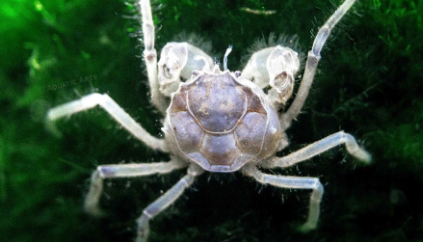
These are the smallest types of aquarium crabs. These species are found in fresh waters of Thailand.
Thai micro crabs are very shy types of species that need to have many hiding spots in the tanks.
For these crabs the aquarium should be at list 19l and needs to be filtered. And plants are preferred as well, as mentioned above they love hiding. So they can hide in plants too.
These crabs are omnivores, thus you can feed them with anything try giving them frozen foods. Also they eat micro-organisms, as well as any food particles floating around the tank.
Also, Thai micro crabs should be kept with calm tank mates as they are very fragile. So preferably keep them with small fish and shrimps. They may be hard to find in fish stores as they are new to the market but you can still find them.
If you have decided to breed Thai micro crabs, then you should know that it is not the easiest task, as many hobbyists say that after the egg hatching the young ones tend to die. So if you are an experienced in crab keeping you can give it a try.
2. Red Claws Crab
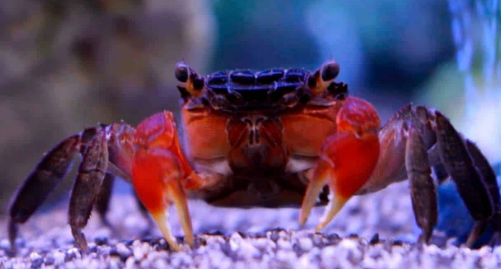
Even if you maintain them in the same tank as snails and fish, they’ll create tension inside the tank due to their history of being overly aggressive. They are nocturnal, like certain crabs, and you may observe them scampering around in the late hours of the night. Males are also territorial, and they will not accept the presence of other males, even from the same species, in the tank.
Aside from that, they are excellent escape artists! As a result, stay on the lookout and maintain the tank sealed throughout since they will take advantage of any opening.
As scavengers, these crabs aren’t picky about what they consume and will eat anything dead or decaying, such as fish.
All crabs are climbers; however, Red Claws are well-known for their prowess in scaling rocks and other aquarium decorations. Aside from that, they’re also superb escape artists, probably even better than other crabs.
3. Fiddler Crab
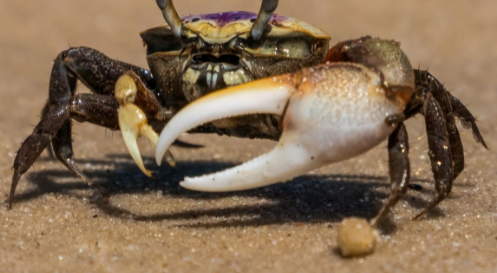
Fiddler crabs seldom grow more than two inches in length. This crab is worth examining since it possesses a single claw equivalent to its whole size. The opposing claw is significantly larger than the opposing claw, and it is generally brightly colored, delicate, and grows quite late. This oversized claw is usually made of gold or yellow metal.
These crabs are not often aggressive. Although they like to travel in couples or small groups, it is best if you purchase a pair at a time by ensuring their compatibility. Aside from that, they enjoy taking cover. Therefore, it’s crucial to make spaces using plants and decorations for these crabs to hide. You may have difficulty locating them in the aquarium decorations since they are so little — exercise caution when attempting to move them to clean the aquarium!
Fiddler crabs are known to survive for hundreds of years in the wild. Although they can be kept in captivity for several years, they are usually released after a few years. Fiddler Crab is a wide term encompassing around 100 distinct kinds of crabs in total. It may be worthwhile for you to conduct some preliminary research before taking one of these crabs into your home to understand its specific requirements to breed.
4. Thai Devil Crab
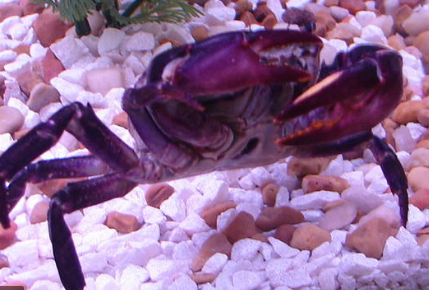
In a paludarium setting, the Thai Devil Crab is a stunning addition to the decor. These invertebrates, like other crabs, require access to both dry ground and water to survive. Because these crabs are freshwater crabs, it is quite simple to maintain optimal water conditions for them.
Thai Devil Crabs are a sight to behold when it comes to their looks. They are capable of taking on a broad spectrum of hues. You’ll most likely see them in purple color. Parts of their bodies, like their heads and claws, are frequently colored in a brilliant red hue to stand out against the rest of their body.
You’ll see lengthy antennae-like eyes protruding from the tops of their heads. Despite their fearsome appearance and frightening name, these freshwater crabs are extremely calm creatures. They can display aggression against smaller fish, although this is mainly reserved for situations when they feel threatened.
Thai Devil Crabs are opportunistic feeders that will eat aquarium algae and plant debris in their habitat. Snacks that are high in protein are also beneficial. They devour brine shrimp and pellets that stay on the tank’s bottom, which they consider tasty.
When it comes to the tank, these crabs require hiding places. They thrive in environments where they have a range of connections to soft sand, which allows them to bury themselves for protection.
5. Panther freshwater crabs
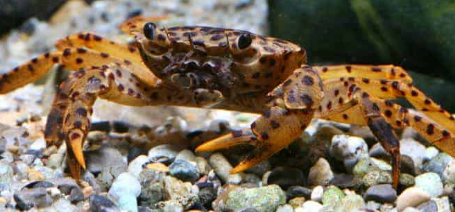
These crabs are found in Sulawesi and are a bit difficult to keep in a tank. But if you like challenging yourself then these crabs will be great for you.
These are rather big species of crabs. And it is recommended to keep them in bigger tanks, especially if you have multiple crabs of the same species. Panther crabs are a bit aggressive, so the larger tank will give them enough space to control their aggressiveness. Also, it is not recommended to keep too many males together.
Panther crabs require land area, such as a rock or something else that can reach to the surface of the water. Also, like many other crab species, Panther crabs need hiding spots, especially at molting period.
6. Ptychognathus barbatus crabs
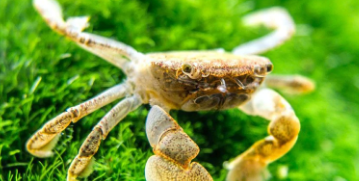
Ptychognathus barbatus is their scientific name, they are also known as freshwater pom pom crabs. The name comes from their filters on their claws that look like pom poms.
These are very peaceful crab species and there are no special tank mate requirements for them. As these species are still new as aquarium crabs, they can be a little bit hard to find. But if you want to have an interesting addition to your tank, then it is highly recommended to keep one of these crabs.
7. Tanganyika crabs
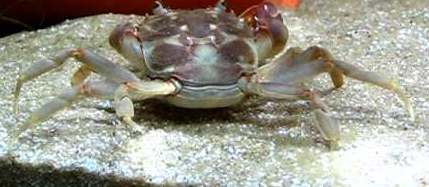
These crabs are found in Lake Tanganyika and that is where they got their name from.
It is recommended to keep them in larger tanks with many hiding spots, as they, like many other crab species like to hide especially during molting period.
These crabs eat anything that they can get into their claws. So it is not recommended to keep them with weak species of fish and snails, as they will probably eat them.
Yet there is not much information about these crab species as they are new for hobbyists. But if you are an experienced aquarium owner then you can try and keep one of these crabs.
8. Vampire crabs
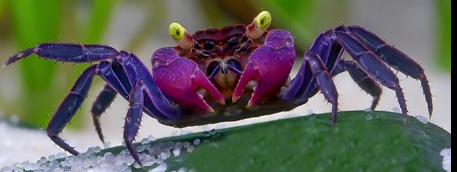
These crab species are called Vampire crabs due to their eyes that are yellow and look as if they are glowing. These are not completely aquatic crab species, but they still need to spend some of their time in fresh water. But you also need to provide them with land. The land are should be planted with moss and many other types of plants. The water needs to have a high level of pH. These crabs are omnivores, so you can feed them with vegetables, frozen food and any other types of food.
A decent land-to-water ratio for just a small colony of Vampire crabs is 2/3 land to 1/3 water, which is a fair compromise. You can adjust this even further to accommodate larger strains of bacteria in bigger tanks. Keep in mind that mature Vampire crabs are rather small, with a leg spread of only 5 – 6 cm (2.5 – 3.5 inches) and a diameter of only 5 – 6 cm (2.5 – 3.5 inches) across the leg span.
Vampire crabs are omnivores, meaning they will consume just about everything from living organisms such as algae to commercial crab (fish or shrimp), pellets (flakes, granules, etc.), and even live insects such as crickets.
9. Freshwater Pom Pom Crab
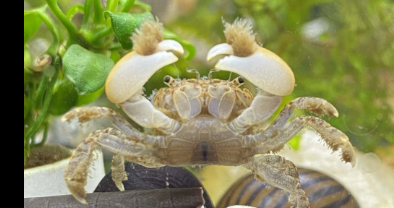
They were given the name “pom-pom” crabs because of their distinctive filter hairs on claws, similar to constantly grasping pom poms. They are found in the African, Asian, and Australian narrow spring freshwater streams. They are indigenous to the Hawaiian Islands and are rather uncommon in the conventional pet trade, and they’re well worth the effort to track down and keep. Crabs that grow up to 3.5 to 5 cm (1.5 to 2 inches) in diameter are known to attain full maturity and are known as “pom-pom” crabs (across the leg span).
It is quite safe to keep them in a communal tank alongside anything that is not going to devour them because they are completely calm filter feeders. They are completely unconcerned with and won’t bother even the tiniest tank mates, making them an excellent complement to Nano aquariums.
“Pom-pom” crabs are completely aquatic and require little maintenance. Except that they are burrowers, they do not have any unique dwelling requirements. Tanks with lots of hiding nooks and plants are appealing.
“Pom-pom” crabs, in contrast to many other kinds of freshwater crabs, are extremely active and not timid creatures. They will bravely explore your tank at all hours of the day and night.
10. Marble Batik Crab
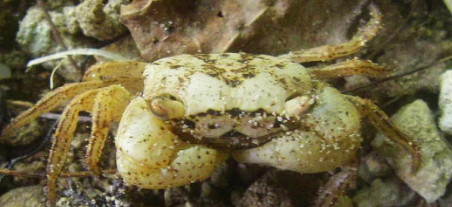
The Marble Batik Crab is an excellent choice if you want a critter that will assist you in keeping your tank clean. It is an excellent scavenger, and it will consume any dead materials in your aquarium. These crabs are widely distributed in the Indo-Pacific. You shouldn’t mix it with the other crab species except with other fishes and fellow Marble Batik Crabs.
As per aesthetics, the Marble Batik Crab seems to have a head that almost resembles a polished, square-shaped marble in terms of texture and shape. The color of the body is usually green, although it may have a variety of patterns and tints. Compared to other crab species, this one spends almost half of its own time on land, significantly more than other freshwater crabs.
11. Blue Spider Crab
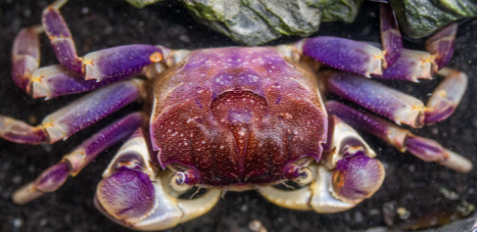
Blue Spider Crab (Neosarmatium rotundifrons) is a semi-terrestrial species that is endemic to the islands of Sumatra, Indonesia, and Samoa. It is a medium-sized, brightly colored crab that is semi-terrestrial. It prefers to live in wooded settings near streams, rivers, ponds, and other habitats. It spends most of its life on land, although it also submerges itself in freshwater occasionally.
12. Red Spider Crab
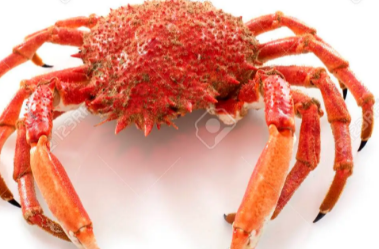
The Red Spider Crab may be found amid leaf litter and other plants. It is necessary to have a large amount of land space in the aquarium. Most of the time, it doesn’t devour good decorative plants but frequently assists in keeping them clean and might even consume dead leaves. It lives in groups with other members of its species; however, males will occasionally fight inside the confines of a tiny cage. Even though this crab can survive in such a freshwater aquarium, it’ll thrive in a brackish environment.
13. Red Apple Crab
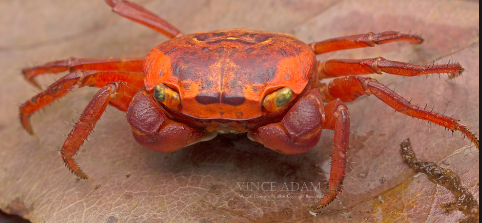
It inhabits forest areas near streams, rivers, and ponds near coastal areas. It spends most of its time on land and is often submerged in freshwater.
The Red Apple Crab is one of our most interesting creatures. Its color varies depending on how it feels at the time. When the crab is satisfied, its shell will change to a vivid red. Its shells turn into a rust-brown coloring when they feel satisfied. They are scavengers, which means they feed on dead animals or fishes to survive.
Red Apple Crabs have a good relationship with various other species. On the other hand, Red Apple Crabs should not be kept alongside other crabs, even those of the same species, because of their hostility. Provide these crabs with dry pats to burrow in and fruits and veggies to consume while digging.
Caring For Freshwater Crabs
Ensure you have enough space in the tank before releasing young freshwater crabs. This includes total space in the tank, including the dry land area, to meet their terrestrial requirements. Because freshwater crabs spend more than half their time out of the water, they require much terrestrial space. Generally, a 2:1 water-to-land ratio is recommended for keeping these crabs in the tank.
You must also clean the water regularly to keep it free of pollutants and toxins. In addition, monitor the saltiness and pH levels of the water to maintain proper water quality in the tank.
Make certain that your crabs have enough food supply or that the other creatures that share their environment do not consume all of the crabs’ supplies. To guarantee that the food doesn’t get eaten by other fishes when you feed them, allow it to settle toward the bottom of the tank, as these crabs are bottom dwellers.
Setting Up A Proper Habitat
Creating an ideal habitat for any freshwater fish and crustaceans is one of the most critical components of caring for freshwater crabs. Having a comfortable location that mimics their natural surroundings is essential. Though you may need to conduct more research to understand your crab’s native environment, understanding the fundamentals is not difficult.
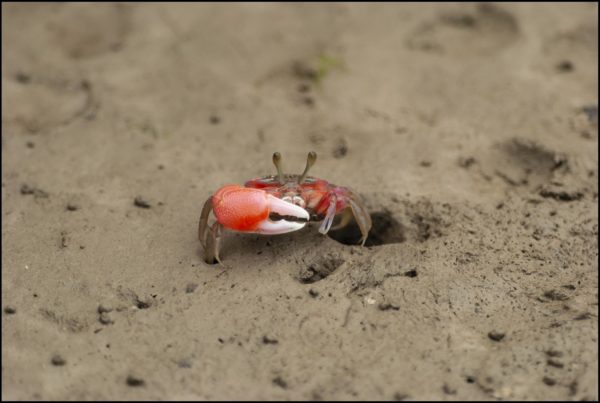
First and foremost, you must check that the tank is large enough! Some crab keepers maintain their crabs in single-species aquariums with no more than 10 gallons in capacity. It is OK for crabs that are a few inches long or ridiculously small in size. In the case of a bigger species like the Rainbow Land Crab, you should look out for larger tanks of 30 gallons or even more.
You’ll then need to find out more about your crab’s land and water requirements, which you can find here. Not all crabs thrive in the water. In reality, most of them divide their time rather equally between land and water-based activities.
This is a very important issue that you must take into account. The area required for your crab’s species, including dry ground, can fit well into a 50-gallon water tank. Otherwise, your crab might develop unpleasant diseases and grow unwell or even drown if you don’t act quickly within the substantial time.
Fortunately, establishing new land areas in the tank is not too difficult. You can use a floating perch or sloping substrate to design your aquarium tank. To make dry regions more approachable to your crab, you can create shelves instead.
Water Conditions
Fiddler crabs are found in both fresh and saltwater habitats in their natural habitat. To replicate their natural habitat, you should prepare a particular salty water solution for them. Use sea salt instead of table salt. If you want to use tap water, keep it sitting out for at least 24 hours before using it. You may also use spring water or dechlorinated water. Afterward, put sufficient salt into the water to lower the specific gravity of the water between 1.005 and 1.010. A hydrometer can be purchased at any local pet store to determine the specific gravity of your water.
Tank Elements
After taking good care of the sand and water in your crab’s aquarium, you may decorate it with various items. Various decorative items are available in aquatic markets, including plastic plants, actual underwater plants, wood, and other appealing items. They stay in fast-moving freshwaters and several elements like trees, boles, and caves in the wild.
Introducing Crabs To The Tank
Introducing freshwater crabs into a tank is not a huge problem for newbie aquarists. Initially, you need to be very careful when introducing new carbs to the aquarium. First, dope them for a few minutes while observing, so you can get it out immediately if something wrong happens. After a few attempts, you will know how they behave or settle.
Feeding Your Pet Crabs
Crabs are rather simple to feed, for the most part. These omnivores will devour the majority of the meals you feed them. These critters are mostly opportunistic, so they will not shy away from tasty treats.
During the day, many freshwater crabs would feast on plant debris or consume algae. You may add blanched veggies such as zucchini or lettuce to this to make it a complete meal.
Finding Suitable Tankmates
When you put your crabs in the tank, make sure they are compatible with the fish already to avoid any problems. Cichlids, for example, are well-known for their aggressive behavior toward crabs. Keep pleasant fishes that your crabs are likely to have a good experience with.
Also, keep in mind that the fishes can be hostile as well. You should keep in mind that crabs are not the greatest of friends with little fish, frogs, and other scourges.
Maintaining The Tank
Daily, you are advised to check the water temperature in your bathtub. Almost all crabs are good aquatic escapers; they easily escape from the tank. Try to keep a lid on the aquarium tank to avoid the crabs going out of the water tank. Nonetheless, even if your tank does not have a lid, you can create one yourself. It can be plastic, acrylic, or placing netting or mesh over the top of the tank.
If the temperature is too high or too low, your crab may suffer from heat or cold stress. Maintain a temperature range of 72-82 degrees Fahrenheit.
Check your filtration system to ensure that it is effectively filtering out any pollutants from your tank water supply.
Warning Signs Of Health Problems In Freshwater Crabs
There is a possibility that they will get common infections such as Salmonella and Atypical Mycobacterium. Children and pregnant people must exercise caution while handling crabs since these illnesses can spread from the crabs to humans.
About Molting
Crabs go through various stages of development during their lifetime. It’s the time of the year when they shed their old shells to make way for new ones.
The intriguing thing about molting is that crabs are extremely susceptible when they have completed their molt. When their new shells are entirely hardened, it will take some time. They are more vulnerable to assaults and injuries during this period.
That is why it is so critical to have concealing places in your design. Crabs are very aware of their vulnerability, and they will spend a significant amount of time searching for protection once they molt.
Don’t be alarmed if you notice a dead crab corpse in the bottom of the tank. Allow it to sit there for a few days before eliminating it from the area. Some crabs will eat their old shells.
Conclusion
Usually some crabs are sold as freshwater crabs in aquarium shops, like fiddle crabs, red claw crabs and many more. But it is just a misconception these are not freshwater crabs and they have their specific requirements which aquarium shop worker are not following.
So hopefully this article answered some of your questions related to freshwater crabs. Overall we can see that these crabs are still not common for aquarium keepers, as it is not so easy to get hold of these crabs. But if you have experience keeping freshwater crabs then you can easily try to keep the species mentioned above and maybe try to tell us your experience of keeping them. Maybe after some time when more people will keep these crab species we will be able to get more information about them. Check out the rest of TheAquariumGuide for more information about fishkeeping.

1 thought on “Everything To Know About Freshwater Crabs (Species List)”
Could you help me identify what species my crab is? It is about 3cm. It has black legs. Its back is black with white spots white there is a orange patch near the eyes. It has a pretty huge pincer that is white at the end but the other is a bit grey.